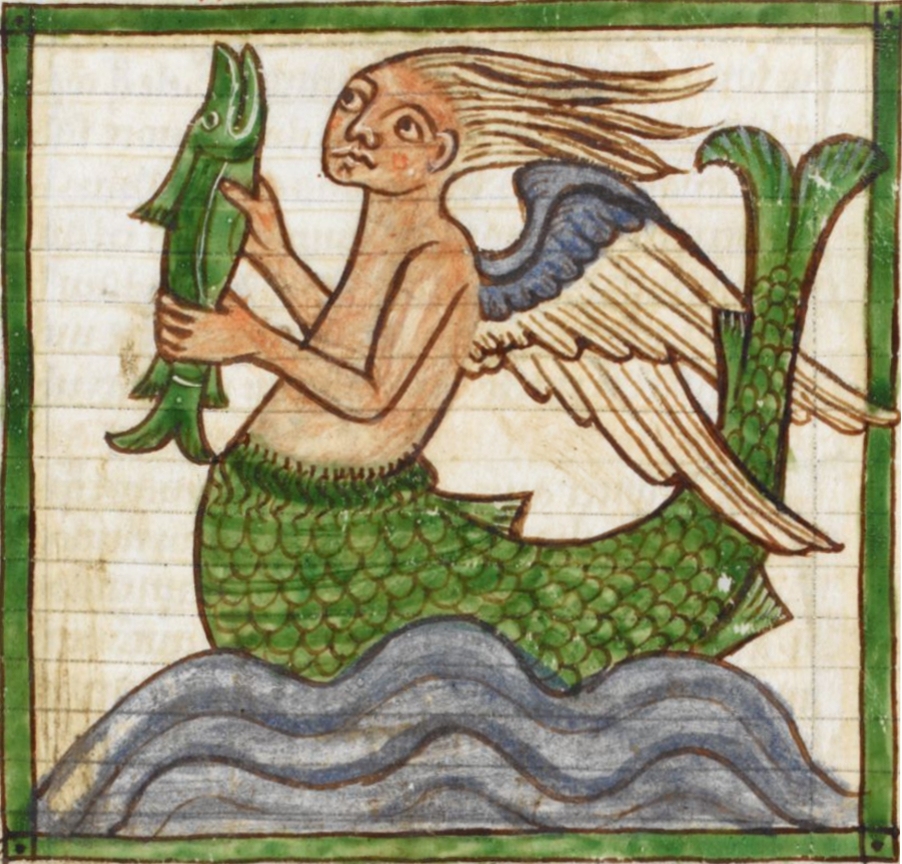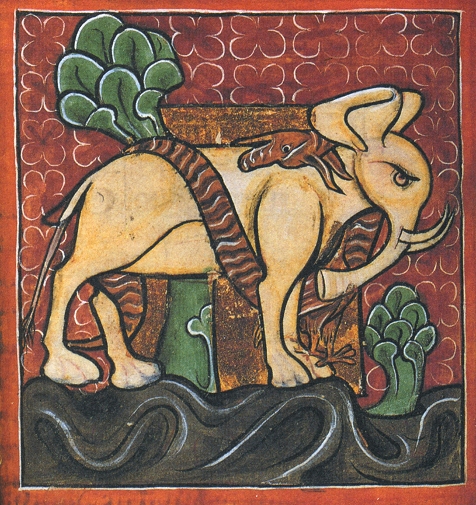- Hafgygr or Margygr
- A sea giantess, of the same type as the mother of Grendel in Beowulf, who was described as 'a monster of a woman, she mourned her fate, she who had to live in the terrible lake, the cold water streams, after Cain slew his own brother.' After her son's battle she had her revenge. Beowulf went in search of her and he saw 'many serpents in the water, strange sea dragons swimming in the lake and also water demons lying on cliff-ledges, monsters and serpents of the same kind as often in the morning molest ships on the sail-road'. Beowulf dived into the lake, where he found Grendel's mother. After being attacked by the sea monsters, he engaged them in a fierce battle at the bottom of the lake, eventually emerging victorious.
- Hedley Kow
- A bogey known to haunt the Northumbrian village of Hedley; he played numerous mischievous tricks by changing his form. The Hedley Kow's name is misleading. In Northern English and Lowland Scots the word "kow" means "goblin" or spirit"; he only sometimes appeared as a cow. He would become a truss of straw which got heavier and heavier when carried until the bearer was forced to put it down. He then shuffled away and laughter was heard. He could also turn himself into two things at once. He was known to become two pretty girls, who encountering two young men, led them off into the bog. He appeared as a favorite cow which led the milkmaid around the meadow, and he would get into the farmhouse, where he would overturn cooking pots, unravel knitting and jam the spinning wheel. He was at his most mischievous when a child was about to be born, and so torment the horse of the man going for the midwife that he would be thrown from the horse into the road. The Hedley Kow always disappeared after playing his pranks with the nicker of a horse-laugh or 'Ha! Ha!'.
- Herne the Hunter
- See the Wild Huntsman
- Hob or Hobthrush
- A brownie found in Yorkshire and Durham, believed to be able to cure children of whooping cough. Parents took their children to the Hobhole and said 'Hobhole Hob, Hobhole Hob, my bairn's got kincough, tak't off! Tak't off!'
- Jenny Greenteeth
- An evil water creature found in Lancashire, which attacks and drowns the unwary; the only sign of its presence is a green scum on the water.
- Kelpie
- See Water Horse
- King Otter
- Found in River Conon at Conon Bridge, Ross and Cromarty, Scotland the King Otter is larger than other otters, and the tale is told that should you catch one you will be granted one wish to secure its freedom. A warrior could become impervious to swords, arrows and bullets if he wore the King Otter's pelt.
- Lavellan
- A beast found in Scotland which had a head like a rat or mouse, and a body of the same color. It was able to injure cattle merely by its presence from a distance of thirty yards or more, but they could be cured by dipping its skin in their water. The water-vole was supposed to have similar powers.
- Leprechaun
- The most famous of Irish fairies, they appeared as dwarfs less than two feet tall. They haunted wine-cellars and were guardians of immense treasures.
- Liver
- A bird said to have frequented the pool near where Liverpool was built. It is depicted in the arms of Liverpool as a cormorant-like creature.
- Mara
- Old English for demon; hence, nightmare. It could be a giant, dwarf, or elfin woman depending on the type of dream. It entered the room through any small space and died if it could not escape at dawn. Women were believed to become demons of this sort and under ecclesiastical law a woman acting as a nightmare and 'riding' a man or his servants was fined or outlawed.
- Mermaids
- Usually shown as beautiful long-haired women with a fish's tail from the waist down, holding a comb and mirror. The seal is at the root of the main Hebridean legends about mermaids; and she has been confused with the seal-maid, who comes ashore and casts her skin. If her skin is removed, she must remain in human shape. Mermaids who took human lovers more frequently exacted a vow of secrecy from them, which if broken meant their return to the water. Mermaids have no souls, and long to acquire them. If they were able to transform themselves into spirits of the air, they could win souls at the end of three hundred years if they behaved themselves. On Iona, round smooth pebbles were said to be the tears of a mermaid who had begged one of the saints on the island to give her a soul, but had been refused.
- Merrows
- An Irish people who lived on dry land below the sea, and passed through the water by means of their enchanted caps. The women were beautiful, but the males were red-nosed and pig-eyed, with green hair and teeth and a liking for brandy. Perhaps this is why the females were so eager to marry humans.
- Merrymaids
- Cornish for Mermaids.
- Morholt
- In the romance of Tristan and Isolde, Tristan fights the Morholt, a knight of superhuman powers and champion of Ireland, in order to free Cornwall from the tribute paid to the Irish king. Originally the Morholt was probably a dragon-like monster from which Tristan rescued Isolde.
- Murrisk
- A creature which inhabited the plain near Croagh Patrick. If it spewed in the water all the fishes died, if it belched fumes it killed all the birds, and if it breathed vapor over the land it killed all living things like a plague.
- Muryans
- Cornish fairies, originally larger than humans, which were condemned to diminish each year until they became ants and died.
Photo credits: (Related Resources) (1) Harley MS 3244, British Library Digitised Manuscripts, PD-Art, Wikimedia Commons, (2) MS Body 764, Bodleian Library, Oxford, England, PD-Art, Wikimedia Commons

